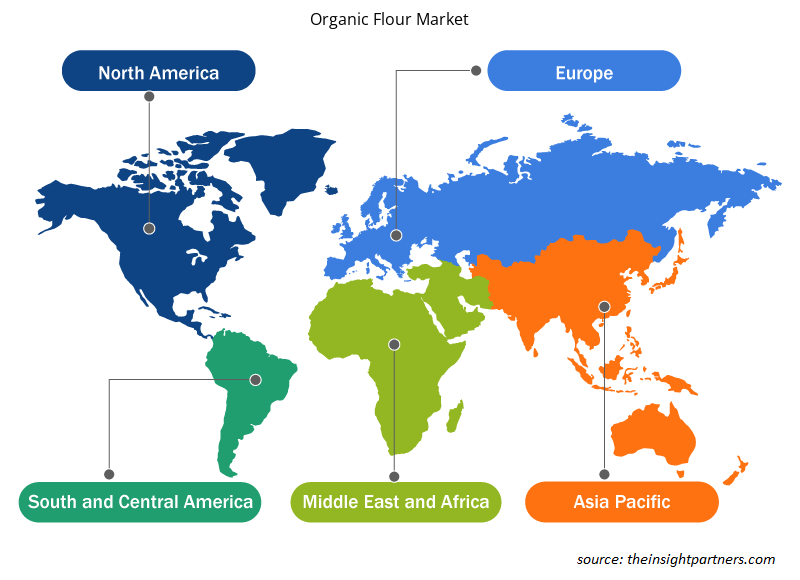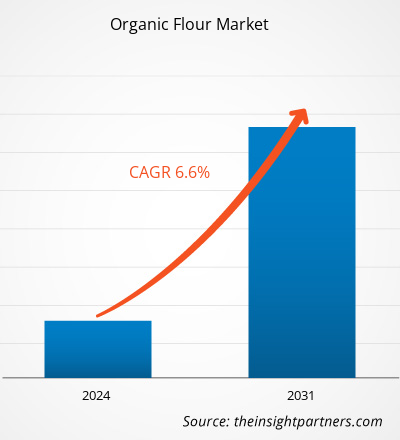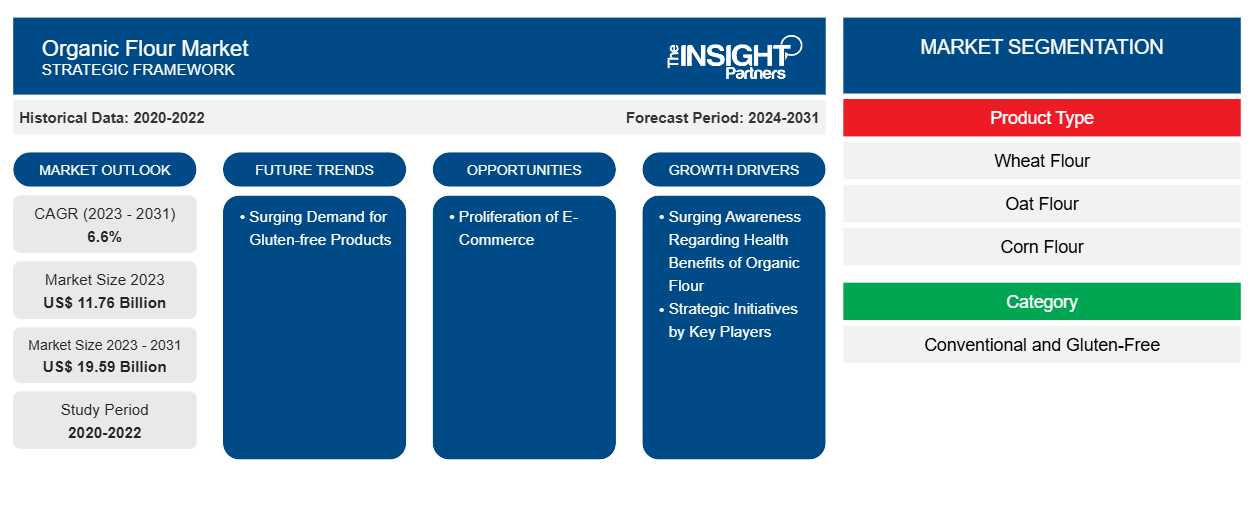유기농 밀가루 시장 규모는 2023년 117억 6천만 달러에서 2031년 195억 9천만 달러로 성장할 것으로 예상되며, 2023년에서 2031년까지 연평균 성장률 6.6%를 기록할 것으로 추산됩니다.
시장 통찰력 및 분석가 관점:
소비자들이 건강을 더 의식하고 유기농 제품을 찾으면서 유기농 밀가루에 대한 수요가 급증했습니다. 유기농 밀가루는 독성 살충제, 합성 비료 또는 유전자 조작 기술 없이 재배된 곡물로 생산됩니다. 건강하고 환경 친화적이며 윤리적으로 생산된 식품에 대한 소비자 선호도가 높아짐에 따라 수요가 급증했습니다. 또한 유기농 식품의 풍부한 영양가와 잠재적 건강상의 이점이 수요 증가에 기여했습니다. 이러한 급증은 최근 몇 년 동안 상당한 성장을 보인 유기농 식품 산업의 더 큰 추세의 일부입니다. 또한 환경적 지속 가능성에 대한 인식이 높아짐에 따라 많은 소비자가 토양 건강과 생물 다양성을 우선시하는 보다 친환경적인 농업 관행을 지원하기 위해 유기농 제품을 선택하고 있습니다. 또한 지역 농부와 소규모 생산자를 지원하고 식품 생산에 대한 투명성을 제공하려는 욕구가 유기농 밀가루에 대한 수요 증가에 기여합니다.
성장 동인 및 과제:
합병 및 인수, 파트너십, 캠페인 출시, 다양한 시장 참여자가 입지를 강화하고 새로운 기회를 활용하기 위해 수행하는 제품 출시와 같은 전략적 이니셔티브는 유기농 밀가루 시장 규모가 성장하는 데 기여할 것으로 예상됩니다. 예를 들어, 2020년에 ADM은 영국에 본사를 둔 유기농 밀가루 제분 회사인 Gleadell Agriculture Ltd.의 나머지 50% 지분을 인수했습니다. 이 인수를 통해 ADM은 유기농 밀가루 시장에서 입지를 확대하고 공급망 역량을 강화할 수 있었습니다. 유기농 밀가루의 이점에 대한 인지도를 높이고 소비자를 교육하는 것을 목표로 하는 캠페인 출시도 시장 성장을 촉진하는 데 중요한 역할을 합니다. 주요 참여자는 종종 유기농 밀가루의 영양적 이점, 환경적 지속 가능성 및 품질 기준을 강조하는 마케팅 캠페인에 투자합니다. 이러한 캠페인은 수요를 창출하고 소비자 선호도를 형성하며 유기농 밀가루 제품을 기존 대안과 차별화하는 데 도움이 됩니다. 이러한 캠페인에는 디지털 광고 , 소셜 미디어 프로모션, 교육 콘텐츠가 포함되어 소비자가 베이킹 및 요리에 유기농 밀가루를 사용하는 이점에 대한 인지도를 높입니다.
제품 출시는 유기농 밀가루 시장에서 경쟁력을 유지하고 진화하는 소비자 선호도를 충족하는 데 필수적입니다. 주요 업체는 지속적으로 혁신하고 특정 식단 요구 사항, 맛 선호도 및 상황에 맞게 조정된 새로운 유기농 밀가루 제품을 출시합니다. 예를 들어, 글루텐이 없는 유기농 밀가루 종류는 글루텐 불내증이나 민감성이 있는 소비자를 대상으로 하는 반면, 아몬드 가루나 코코넛 가루와 같은 특수 밀가루는 대체 베이킹 재료를 찾는 건강을 의식하는 소비자에게 어필합니다. 예를 들어, 2021년에 Hodgson Mill은 유기농 통밀가루, 유기농 다용도 밀가루, 유기농 페이스트리 밀가루를 포함한 새로운 유기농 밀가루 라인을 출시하여 베이킹 요구 사항에 대한 유기농 대체품을 찾는 소비자를 대상으로 하고 Hodgson Mill이 유기농 밀가루 옵션에 대한 증가하는 수요를 충족하려는 노력을 보여주었습니다. 또한 여러 회사가 유기농 밀가루와 같은 제품을 출시하여 유기농 시장에 진출하고 있습니다.
USDA와 EU 유기농 규정을 포함한 규제 기관에서 의무화한 엄격한 표준 및 인증 프로세스와 같은 유기농 밀가루와 관련된 규정 준수는 글로벌 유기농 밀가루 시장 성장을 억제할 것으로 예상됩니다. 유기농 인증을 취득하려면 포괄적인 검사, 문서화 및 특정 유기농 농업 관행 준수가 필요하며, 이 모든 것이 생산자에게 상당한 시간과 재정적 투자를 요구합니다. 이러한 철저한 프로세스는 소규모 생산자나 자원이 제한된 생산자에게 장애물로 작용하여 유기농 밀가루 시장에 진입하거나 확장하는 능력을 방해할 수 있습니다.
귀하의 요구 사항에 맞게 이 보고서를 사용자 정의하세요
이 보고서의 일부 또는 국가 수준 분석, Excel 데이터 팩을 포함하여 모든 보고서에 대한 사용자 정의를 무료로 받을 수 있으며 신생 기업 및 대학을 위한 훌륭한 혜택과 할인 혜택을 이용할 수 있습니다.
-
이 보고서의 주요 시장 동향을 알아보세요.이 무료 샘플에는 시장 동향부터 추정 및 예측까지 다양한 데이터 분석이 포함됩니다.
보고서 세분화 및 범위:
"글로벌 유기 밀가루 시장 분석"은 다음 세그먼트를 고려하여 수행되었습니다. 제품 유형, 범주, 유통 채널 및 지역. 제품 유형을 기준으로 유기 밀가루 시장은 밀가루, 귀리 밀가루, 옥수수 밀가루, 쌀 밀가루 등으로 세분화됩니다. 범주를 기준으로 시장은 기존 및 글루텐 프리로 세분화됩니다. 유통 채널별로 시장은 슈퍼마켓 및 하이퍼마켓, 편의점, 온라인 소매점 등으로 세분화됩니다. 유기 밀가루 시장 보고서의 지리적 범위는 북미(미국, 캐나다 및 멕시코), 유럽(독일, 프랑스, 이탈리아, 영국, 러시아 및 기타 유럽), 아시아 태평양(호주, 중국, 일본, 인도, 한국 및 기타 아시아 태평양), 중동 및 아프리카(남아프리카, 사우디 아라비아, UAE 및 기타 중동 및 아프리카), 남중미(브라질, 아르헨티나 및 기타 남중미)에 초점을 맞춥니다.UAE, and the Rest of Middle East & Africa), and South & Central America (Brazil, Argentina, and the Rest of South & Central America).
세그먼트 분석:
제품 유형에 따라 시장은 밀가루, 귀리 가루, 옥수수 가루, 쌀 가루 등으로 세분화됩니다. 유형에 따라 글루텐 프리 세그먼트는 2030년까지 상당한 유기농 밀가루 시장 점유율을 차지할 것으로 예상됩니다. 글루텐 프리 밀가루는 셀리악병이나 글루텐 민감증이 있는 사람과 글루텐 프리 식단을 선택하는 사람을 위해 설계되었습니다. 글루텐 프리 클레임 제품에 대한 수요는 글루텐 관련 질환의 유병률 증가와 더 광범위한 건강 의식 추세로 인해 상당히 급증했습니다. Beyond Celiac에 따르면 미국에서 133명 중 1명, 즉 인구의 약 1%가 셀리악병을 앓고 있습니다. 셀리악병에 대한 인식으로 인해 많은 소비자가 글루텐 프리 대체품을 찾게 되었고, 이로 인해 식단 제한을 충족하는 제품에 대한 상당한 시장이 형성되었습니다. 게다가 글루텐 프리 옵션이 더 건강할 수 있다는 인식으로 인해 건강 문제가 있는 사람 외의 소비자 기반이 확대되어 글루텐 프리 세그먼트의 유기농 밀가루 시장이 지속적으로 성장하는 데 기여했습니다.
지역 분석:
지리적으로 볼 때, 시장은 북미, 유럽, 아시아 태평양, 남미 및 중미, 중동 및 아프리카의 5개 주요 지역으로 구분됩니다. 수익 측면에서 북미는 글로벌 유기농 밀가루 시장 점유율을 지배했습니다. 북미 시장은 2023년에 약 29억 달러를 차지했습니다. 아시아 태평양 유기농 밀가루 시장은 예측 기간 동안 가장 높은 CAGR로 성장할 것으로 예상됩니다. 아시아 태평양 지역은 급속한 도시화와 변화하는 소비자 라이프스타일을 경험하고 있습니다. 도시 소비자들은 수제 빵, 페이스트리 및 기타 제빵류의 중요한 재료로 유기농 밀가루를 찾습니다. 또한, COVID-19 팬데믹과 같은 요인으로 인해 홈 베이킹으로의 전환이 가속화되어 더 많은 소비자가 집에서 요리와 제빵을 탐구하게 되었습니다. 그 결과, 다재다능하고 영양가 있는 제빵 재료로서 유기농 밀가루에 대한 수요가 아시아 태평양에서 상당히 증가하여 시장 확장을 뒷받침했습니다.
아시아 태평양은 다양한 농업 경관과 전통적인 농업 관행을 갖추고 있어 유기농 밀가루 생산에 충분한 기회를 제공합니다. 인도, 중국, 호주와 같은 국가는 지속 가능한 농업과 유기농 인증 프로그램을 촉진하는 정부 정책의 지원을 받는 유기농 농업 이니셔티브가 증가하는 것을 목격했습니다. 유기농 농업에 대한 이러한 관심 증가로 인해 이 지역에서 생산되는 유기농 곡물과 밀가루의 가용성이 증가했습니다. 건강과 웰빙에 대한 인식이 증가함에 따라 아시아 태평양의 유기농 밀가루 시장이 성장하고 있습니다.
유럽은 또 다른 주요 기여자로, 글로벌 시장 점유율의 30% 이상을 차지하고 있습니다. 유럽 전역의 소비자들은 식품 안전, 환경적 지속 가능성, 농업 관행이 공중 보건에 미치는 영향에 대해 점점 더 우려하고 있습니다. 이로 인해 밀가루를 포함한 유기농 제품에 대한 선호도가 높아지고 있습니다. 유럽의 소비자들은 합성 살충제, 제초제 또는 GMO 없이 생산된 유기농 밀가루를 적극적으로 찾고 있으며, 이를 기존 밀가루보다 훨씬 안전하고 환경 친화적인 옵션으로 보고 있습니다. 유기농 밀가루로의 이러한 전환은 또한 많은 유럽인이 더 건강하고 자연스러운 음식 선택을 선택하면서 소비자 라이프스타일과 식단 선호도의 변화로 인해 촉진되었습니다.
유기 밀가루 시장 지역 통찰력
Insight Partners의 분석가들은 예측 기간 동안 유기 밀가루 시장에 영향을 미치는 지역적 추세와 요인을 철저히 설명했습니다. 이 섹션에서는 북미, 유럽, 아시아 태평양, 중동 및 아프리카, 남미 및 중미의 유기 밀가루 시장 세그먼트와 지리에 대해서도 설명합니다.

- 유기 밀가루 시장에 대한 지역별 특정 데이터 얻기
유기 밀가루 시장 보고서 범위
| 보고서 속성 | 세부 |
|---|---|
| 2023년 시장 규모 | 117억 6천만 달러 |
| 2031년까지 시장 규모 | 195억 9천만 달러 |
| 글로벌 CAGR (2023-2031) | 6.6% |
| 역사적 데이터 | 2020-2022 |
| 예측 기간 | 2024-2031 |
| 다루는 세그먼트 |
제품 유형별
|
| 포함된 지역 및 국가 |
북아메리카
|
| 시장 선도 기업 및 주요 회사 프로필 |
|
유기 밀가루 시장 참여자 밀도: 비즈니스 역학에 미치는 영향 이해
유기농 밀가루 시장은 소비자 선호도의 변화, 기술 발전, 제품의 이점에 대한 인식 증가와 같은 요인으로 인해 최종 사용자 수요가 증가함에 따라 빠르게 성장하고 있습니다. 수요가 증가함에 따라 기업은 제품을 확장하고, 소비자의 요구를 충족하기 위해 혁신하고, 새로운 트렌드를 활용하여 시장 성장을 더욱 촉진하고 있습니다.
시장 참여자 밀도는 특정 시장이나 산업 내에서 운영되는 회사나 기업의 분포를 말합니다. 주어진 시장 공간에 얼마나 많은 경쟁자(시장 참여자)가 존재하는지 그 규모나 총 시장 가치에 비해 나타냅니다.
유기 밀가루 시장에서 활동하는 주요 회사는 다음과 같습니다.
- 홈타운푸드컴퍼니
- 밥스 레드 밀 내추럴 푸드
- 킹아서베이킹컴퍼니
- 코로
- 베터바디푸드 C/O
- FWP 매튜스 유한회사
면책 조항 : 위에 나열된 회사는 어떤 특별한 순서에 따라 순위가 매겨지지 않았습니다.

- 유기농 밀가루 시장의 주요 주요 업체 개요를 알아보세요
산업 발전 및 미래 기회:
유기농 밀가루 시장 전망은 이해관계자가 성장 전략을 계획하는 데 도움이 될 수 있습니다. 다음은 유기농 밀가루 시장에서 활동하는 주요 업체가 취한 이니셔티브입니다.
- 2022년, Amul 브랜드로 제품을 판매하는 유가공 대기업 GCMMF는 유기농 밀가루 출시로 유기농 식품 시장에 진출한다고 발표했습니다. 이 포트폴리오에서 출시된 첫 번째 제품은 "Amul Organic Whole Wheat Atta"입니다.
경쟁 환경 및 주요 회사:
Hometown Food Company, Bob's Red Mill Natural Foods, Betterbody Foods C/O, FWP Matthews Ltd, Shipton Mill Ltd, W and H Marriage and Sons Limited, Gilchesters Organics, Anita's Organic Grain & Flour Mill Ltd.는 유기농 밀가루 시장 보고서에 소개된 주요 기업 중 일부입니다. 글로벌 시장에서 활동하는 기업은 고객 수요를 충족시키기 위해 고품질 제품을 제공하는 데 중점을 둡니다. 또한 시장에서 경쟁력을 유지하기 위해 신제품 출시, 용량 확장, 파트너십, 협업과 같은 다양한 전략을 채택하고 있습니다.
- 과거 분석(2년), 기준 연도, CAGR을 포함한 예측(7년)
- PEST 및 SWOT 분석
- 시장 규모 가치/거래량 - 글로벌, 지역, 국가
- 산업 및 경쟁 환경
- Excel 데이터세트
최근 보고서
사용 후기
구매 이유
- 정보에 기반한 의사 결정
- 시장 역학 이해
- 경쟁 분석
- 고객 인사이트
- 시장 예측
- 위험 완화
- 전략 기획
- 투자 타당성 분석
- 신흥 시장 파악
- 마케팅 전략 강화
- 운영 효율성 향상
- 규제 동향에 발맞춰 대응























 무료 샘플 받기 - 유기농 밀가루 시장
무료 샘플 받기 - 유기농 밀가루 시장